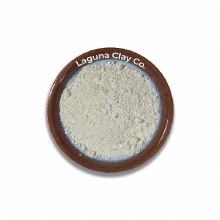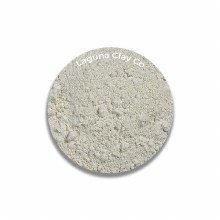Unimin Kaolin, D10 (Sub for E.P.K) (50# Bag)
| Qty: | Unit Price per LB: |
|---|---|
| 5 | $1.10 |
| 10 | $0.98 |
| 50 | $0.73 |
| 100 | $0.61 |
Item#: MKAOD10
MPN: MKAOD10
Alternate Names: China Clay, Generic Kaolin
Description: Hydrated alumina silicate, Pure clay mineral
- Full bag is 50 lbs
A wide array of kaolin (also known as China Clay) products are available. These vary in plasticity, crystal and surface chemistry, particle shape and size, flow properties, permeability, etc. However the most common varieties most people will see are two: kaolins intended for plastic bodies or casting ones. Plastic kaolins can rival the workability of a ball clay, casting ones can be so short that it is difficult to even wedge or roll them without the plastic mass falling apart. Strangely, non-plastic kaolins are not necessarily whiter burning.
Pure kaolin is the clay of choice for bodies that need to be clean and white. Many porcelains contain only a kaolin mix as their clay complement. But kaolins have relatively low plasticity when compared to other raw clay types. Thus in non-casting plastic-forming bodies it is often not possible to achieve enough plasticity employing kaolin alone. Additions of ball clays, bentonites and other plasticizers are thus common. Where translucency and whiteness are paramount, highly plastic kaolins and white burning ball clays and bentonites can be used .
Because kaolinite mineral has a much larger particle size than ball clay and bentonite materials, blending it with them in bodies can produce a good cross-section of ultimate particle sizes (this imparts enhanced working and drying properties). Another advantage of the larger particle size of kaolins is that they are much more permeable to the passage of water. Thus kaolins, especially the larger sized ones, speed up casting rates in slurry bodies and drying rates in all bodies.
Kaolins are employed in glaze recipes to keep the silica, feldspar, frit and other particles from settling out (the surface chemistry of the particles and their interaction with water are responsible for this behavior). At the same time the oxide chemistry of kaolin makes it the primary source of alumina oxide for glazes.
Kaolin is a very refractory aluminum silicate. Kaolin-based bodies are used to make all kinds of refractory parts for industry. Kiln wash is often made from 50:50 mix of kaolin and silica. Cordierite is made mainly from kaolin. High-heat-duty grogs are made by calcining kaolin.
Kaolin is used in many industries other than ceramics, in fact the ceramics industry uses only a small amount of the total kaolin produced. Kaolin companies tend to be billion-dollar operations and kaolin is used in everything from paper to cosmetics, paint to agricultural products. The spread of pictures across the page at the Ukranian Kaolin Company shows some examples: http://www.ukc-kaolin.com/en/product.html
If you use kaolin in your production there is good reason to be doing routine quality control to make sure it remains consistent. Kaolins can sometimes have particulate impurities (can cause firing specks) and exhibit differences in soluble salts content, drying shrinkage, drying performance and behavior in slurries. Different name-brand kaolins, and even different ones marketed by the same company, can have very different properties. The plasticity range can be huge (from almost zero to like ball clay). Fired color and fired maturity can be very different. If you make a porcelain, for example, it is very important to compare fired maturity of the recipe using the original and new kaolin (using the SHAB test for example). It is often necessary to compensate fired maturity changes by adjusting the feldspar percentage. And plasticity changes by adding/removing bentonite or adjusting the ball clay/kaolin proportion. Also, just because a clay fires really white does not mean it is a koalin, even if the supplier calls it such.
Kaolin transforms to mullite above 1000C, this is a key factor in the micro structure of porcelain and other types of bodies. This transformation is also exploited in engobes.




Share:
Share on Facebook Share on Twitter Share on Pinterest Tell a friend